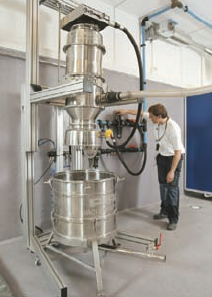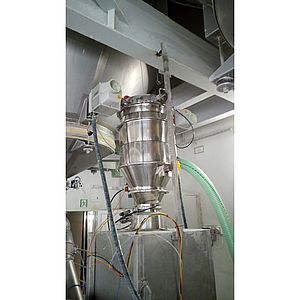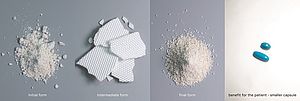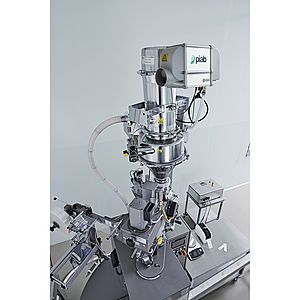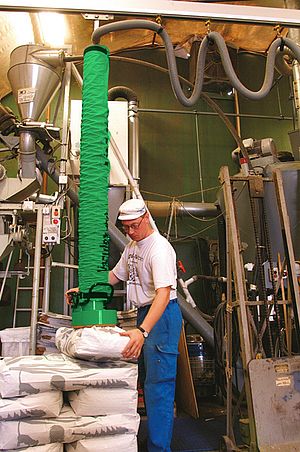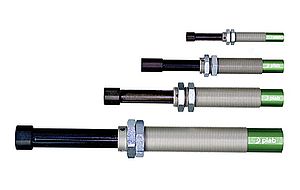The potential for growth in tablet manufacturing is high. However, several challenges and trends are threatening the profit potential. Today, pharmaceutical manufacturers are challenged to evolve their production processes in order to survive and excel in an increasingly competitive industry. While product quality has always been of paramount importance, strenuous economic times and continually inflating drug prices are heightening consumer demand for lower-priced prescriptions. Tablet manufacturers are more than ever seeking new ways to automate their lines to speed and streamline production, and vacuum conveying technologies are providing an answer.
By automating the conveying process, vacuum technologies can improve productivity and enhance quality. In addition, selecting a vacuum technology that is maintenance-free and energy-efficient can provide further benefits to tablet manufacturers. These benefits allow companies to cut costs and meet challenging consumer demands for quality pharmaceuticals and lower prices.
Offering a safer environment
In general, reducing manual labor through automated vacuum conveying can improve working conditions by reducing heavy lifting. In addition, American manufacturers must abide by Safety, Health and Environment (SHE) regulations enforced by the US Department of Occupational Safety & Health Administration. In Europe, the European Foundation for the Improvement of Living and Working conditions (EUROFOUNDA) oversees the improvement of industrial working conditions.
Heat, dust and noise are all pollutants in the working environment that detract from worker safety and the stringent sanitation demands for pharmaceutical and chemical production. Tablet manufacturers can greatly reduce manual labor and diminish exposure to environmental irritants with the installation of a vacuum conveying solution that moves dry powder products through dedicated pipe systems. These systems fully contain the powders to minimize dust and also generate less heat.
To ensure the highest standard of worker safety, the conveyors should also have few moving parts, and be easily assembled and disassembled to reduce worker strain.
In one example of the benefits of vacuum conveying technology, Surepharm Services Ltd, a UK contract manufacturer specializing in tablet production, improved its working environment by reducing the amount of heavy lifting and manual labor performed by its employees. The company replaced its manual loading operation with three C-Series vacuum conveyors to transfer powder products to blending and tableting machinery. As a result, the company saved up to 30 hours of labor per week and reduced dust significantly. Additionally, the lightweight conveying equipment quickened the cleaning process by reducing the physical demand on the workers.
Increasing uptime
Given the 24/7 production runs in pharmaceutical manufacturing, automation technologies must be highly reliably. In today’s competitive pharmaceutical industry, there is simply no time for line stoppages or ongoing maintenance. Additionally, changeover can add significant costs and downtime to the production process. A vacuum conveyor must easily facilitate changeover or risk negating the gains realized through automation.
Simple solutions can effectively combat the erosion of productivity caused by line stoppages, maintenance or changeover. Vacuum technologies with few moving parts are not only safer; they are maintenance-free and can reduce downtime. Conveyors that are easily handled by workers are more quickly assembled and disassembled, reducing the time it takes for equipment adjustments between batches and during cleanings. Machines containing fewer components also help minimize part mix-ups and help to prevent line stoppages.
In one instance, Rottendorf Pharma, one of Germany’s leading contract manufacturers of solid dosage form drugs, replaced its traditional vacuum conveying machines with C2100-64 compact compressedair conveyors. The PIAB conveyors were lighter in weight and contained fewer parts. This made them easier and faster for workers to assemble and disassemble. As a result, the company reduced cleaning time from 7,200 hours to 6,600 hours yearly. The hours saved from cleaning were recycled back into manufacturing time and Rottendorf has improved productivity by 15 million tablets since the installation.
Cost-effective, easy cleaning
In addition to aiming to reduce changeover time, tablet manufacturers must also prevent cross-contamination of the product. A vacuum conveyor that is easily disassembled for quick clean-up is a cost-efficient way of averting cross contamination. In Rottendorf’s example, the light-weight conveyors that replaced its older equipment offered a way to quicken the cleaning process and maximize uptime.
Clean-in-place systems are effective but costly solutions to meeting strict FDA regulations on sanitary conditions. Additionally, the systems can add unnecessary bulk to existing equipment.
Energy-saving solutions
As energy costs soar, the reduction of energy usage is a strategic step to trim expenses from pharmaceutical manufacturing operations. In addition, reducing energy consumption is good for sustainability efforts. However, in terms of energy consumption, not all vacuum solutions are created equal.
Conveying systems powered by decentralized vacuum technologies are more energy-efficient than their centralized counterparts. While a centralized vacuum system puts more distance between the source of the power and the point of use, a decentralized vacuum system uses multistage ejector technology to apply the vacuum where needed. This way, no additional energy is expended to compensate for the extra distance.
Optimizing automation
Automating the tablet-handling process affords many advantages and conveniences to pharmaceutical manufacturers, including increased productivity and reduced staff injury. However, poorly designed automated conveying systems can cause segregation and tablet breakage. Simple precautions can be taken to avoid incurring the costs of product waste as a result of either event.
Preventing Segregation
Particle separation prior to tablet compression, known as segregation, can threaten the integrity of drug dosages and jeopardize the uniformity of a batch. Segregation can occur during tablet production as a result of gravity and particle characteristics as well as due to external factors such as air flow and vibration.
When implementing vacuum conveying, segregation risk can be significantly reduced by handling the material at a controlled speed to ensure that the materials stay blended.
Preventing Tablet Breakage
Tablets can also break due to exposure to friction and shock during or after the manufacturing process. A broken tablet is susceptible to contamination, rendering it useless. As a result, product waste can accumulate and cause production delays.
To prevent breakage, tablet manufacturers can employ an accommodating vacuum conveying system. To start, the conveying system should have an adaptable feed rate to enable the system to be sped up or slowed depending on the size or volume of the tablets being handled.
Also, the vacuum conveyor’s tubing and piping specifications along with couplings can be specifically designed to reduce speed and avoid product damage. The tubing and piping should have soft curves to avoid tablet breakage.
Conclusion
Vacuum automation technologies can play a key roll in streamlining tablet production. By taking the right precautions in installing a reliable, efficient vacuum conveying system, manufacturers can increase their productivity, reduce energy usage and improve their work environments. As companies harness vacuum technology to advance tablet production, more efficient conveying systems will translate into cost savings, helping tablet manufacturers stay competitive by enabling them to produce more affordable prescriptions.
By Häla El Sheemy Washbrook, Business Unit Manager, Pharma & Chem, PIAB
Tablet Production & Handling with Vacuum Technologies
Compressed tablets are still the most popular dosage form for pharmaceuticals. Over 75% of pharmaceutical products are sold in solid dosage form. Strong growth is predicted for compressed tablets due to the nutraceuticals market, especially in the USA.
- by Piab AB
- May 4, 2009
- 1295 views



